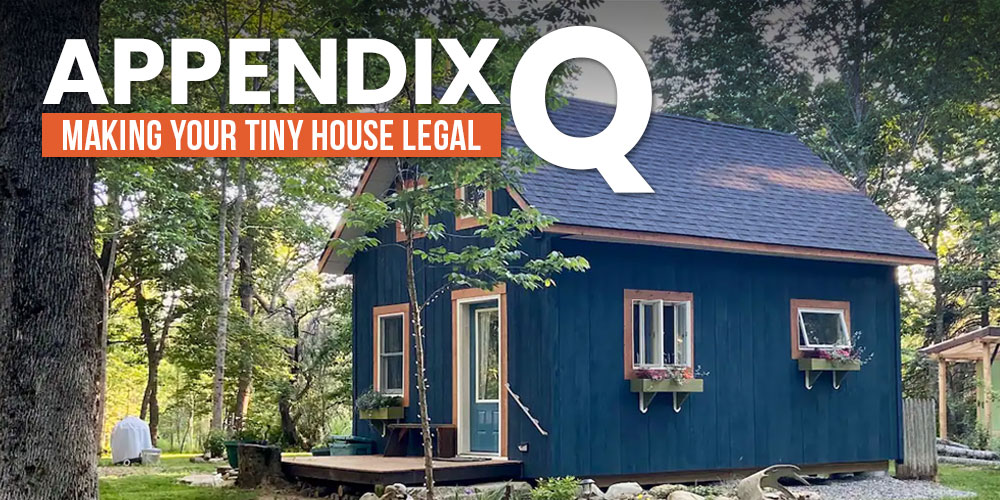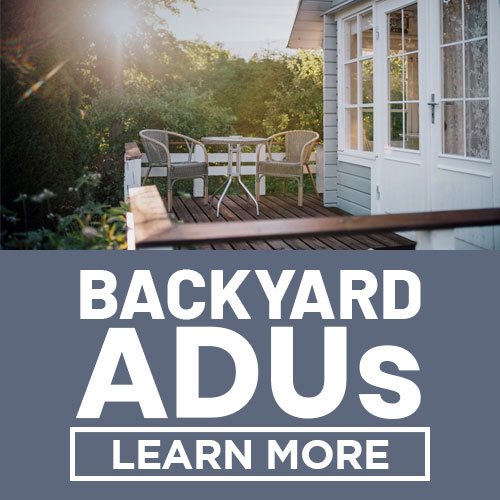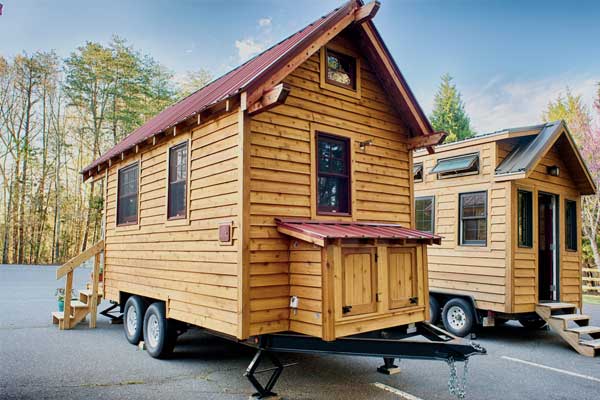
NAVIGATION
In the tiny house world, there is a lot of talk about Appendix Q and what it has done for tiny housers. If you are new to tiny houses, you may not have heard about Appendix Q and everything it has done for the movement.
Before Appendix Q, whether or not your tiny house was legal was a total gamble. There wasn’t a lot of clarity surrounding building and zoning laws because the movement was pretty new.
The creation of Appendix Q in 2018 made life so much easier for tiny homeowners everywhere. It’s definitely worth celebrating and understanding if you plan to live the tiny life in the near future.

Hi, I’m Ryan
About 10 years ago I ventured into the tiny house lifestyle by building a tiny house all on my own. There weren’t a ton of resources out there at the time, so I had to do a lot of research. Since then, the movement has grown with laws like Appendix Q that make living tiny easier!

How Each State Applies Appendix Q
The color code below will help you quickly identify how each state incorporates Appendix Q into their building regulations.
Fully Integrated
Partly Integrated
Not Integrated
CLICK TO JUMP TO YOUR STATE
Alaska
Arizona
Arkansas
California
Colorado
Connecticut
Delaware
Florida
Georgia
Hawaii
Idaho
Illinois
Iowa
Kansas
Kentucky
Louisiana
Maine
Maryland
Massachusetts
Michigan
Minnesota
Mississippi
Missouri
Montana
Tiny House Laws: What Is Appendix Q?

Basically, Appendix Q is an addition to the International Residential Code (IRC) that was approved for inclusion in the 2018 version of the IRC. It was the first appendix ever to create specific requirements for tiny houses.
The creation of Appendix Q was huge. Those who had been following the tiny house movement or living tiny already were thrilled at the Code Council’s decision to add Appendix Q to the IRC.
This is because Appendix Q directly addresses building features that specifically apply to tiny homes like smaller square footage, lofts, ladders, and more. It changed the game for the tiny house community.
What Is The International Residential Code?

Appendix Q is an addition to the International Residential Code, also known as the IRC. The IRC is “a comprehensive, stand-alone residential code that establishes minimum regulations for one and two-family dwellings and townhouses using prescriptive provisions.”
 It is currently being used in 49 U.S. states, the District of Columbia, Guam, Puerto Rico, and the U.S. Virgin Islands. In 2022, Wisconsin is the only state that does not use the IRC building codes, and it is only used in some parts of Alaska.
It is currently being used in 49 U.S. states, the District of Columbia, Guam, Puerto Rico, and the U.S. Virgin Islands. In 2022, Wisconsin is the only state that does not use the IRC building codes, and it is only used in some parts of Alaska.
The regulations outlined in the IRC apply to all single and multi-family dwellings and include safety regulations. For tiny homeowners, it’s important to keep in mind that your tiny house must be up to code with the entire IRC, and not just Appendix Q.
When I was first starting out, I didn’t entirely understand the way the IRC works. It’s easy to be misled into thinking that Appendix Q is the only section of the IRC a tiny homeowner needs to follow, but this isn’t actually the case.
Appendix Q is an addition to the IRC, meaning it lays out additional regulations the original version of the code doesn’t mention. This does not mean that the rest of the IRC does not need to be followed when building a tiny home.
What Is The International Code Council?

Before getting into tiny living and making the choice to build my own tiny house, I honestly didn’t know a lot about building codes. Ten years into my journey, I’ve really learned a lot.
 The IRC was created by the International Code Council (ICC), which is a nonprofit organization that creates standards related to building safety and fire prevention safety that are used by legislative bodies all over the world.
The IRC was created by the International Code Council (ICC), which is a nonprofit organization that creates standards related to building safety and fire prevention safety that are used by legislative bodies all over the world.
The ICC has 340 independent chapters across the world, all connected to their origin chapter in Washington, DC. The codes created by the organization cover many forms of building and safety regulations that are followed by all 50 American states and many other foreign countries.
How Was Appendix Q For Tiny Homes Created?

It was quite the journey getting Appendix Q to where it is today. Appendix Q was first drafted in 2016 by educator, builder, and tiny house enthusiast Andrew Morrison with the help of architect Martin Hammer.
These two men who are extremely passionate about tiny houses got a group of tiny housers together to present their draft to the International Code Council (ICC). When the code was approved and added to the IRC in 2018, it led to huge changes in the movement.
Appendix Q Media Resources:
- ICC Pulse Podcast: Episode 9
- Living Tiny Legally: A Documentary
- Cracking The Code For Tiny Houses Book
Do All Tiny Houses Use Appendix Q?

How do you know whether or not you should use Appendix Q as your legal guide for your own tiny house? Appendix Q works wonders for the tiny house community as far as clarifying what’s allowed and giving tiny homeowners more wiggle room to build in ways that make sense.
However, there are a lot of different ways to live tiny, and Appendix Q doesn’t exactly cover all of them. The IRC lays out the type of tiny houses Appendix Q applies to at the beginning of the appendix.
Appendix Q Applies To:
- Tiny houses on foundation
- Tiny houses that are 400 square feet or less
Does Appendix Q Apply To Tiny Houses On Wheels?

No, Appendix Q is only for tiny houses on foundation. If your tiny house is on wheels, you should not use Appendix Q as your legal guide. Tiny houses on wheels are regulated by each individual state in a different way.
Many states classify tiny houses on wheels as recreational vehicles, and thus, building regulations should come from your respective state RV laws. Some states have their own classification for a tiny house on wheels, some classify them as mobile homes, and some outlaw them altogether.
Defer to your local municipality within your own state for laws surrounding your tiny house on wheels. The IRC is only valid for residential dwellings, which does not include mobile tiny homes.
Does Appendix Q Apply To Tiny Houses As ADUs?

Appendix Q can apply to ADUs, but it doesn’t always. The answer to whether or not Appendix Q applies to accessory dwelling units is a bit of a toss-up. The International Residential Code explains that Appendix Q applies to tiny houses used as single dwelling units.
 Chapter 11 of the IRC defines a “dwelling unit” as “a single unit providing complete independent living facilities for one or more persons, including permanent provisions for living, sleeping, eating, cooking, and sanitation.”
Chapter 11 of the IRC defines a “dwelling unit” as “a single unit providing complete independent living facilities for one or more persons, including permanent provisions for living, sleeping, eating, cooking, and sanitation.”
With ADUs, this gets a bit tricky, because many people have dreams for their ADUs that go beyond a full-time living space. You might want to create a workout room, home office, or pottery studio as a secondary dwelling on your property.
My best advice if you are unsure whether or not to use Appendix Q to build your accessory dwelling unit is to contact your local government or the builder you are using for your ADU. Local municipalities and building companies tend to be experts on the building laws in the area they serve.
Don’t hold back when it comes to reaching out for legal help to build your tiny house! It’s much wiser to get your questions answered on the front end than to spend a pretty penny making changes to your structure after it’s already built.
Appendix Q Guidelines: Tiny House Building Requirements

So, what does Appendix Q actually say? Appendix Q lays out building laws for tiny homes that pay special attention to tiny house specific features such as compact stairs, stair railings, ladders, reduced ceilings heights, loft and loft guard requirements, emergency escape and rescue openings, and more.
The code is written with a lot of legal jargon, but the regulations are fairly simple. In a nutshell, these are the basic requirements that Appendix Q outlines for tiny homeowners.
Tiny House Requirements In Appendix Q
- Be built on a minimum of 320 sq. ft. of land.
- Be a minimum size of 120 sq. ft.
- Have at least one habitable room which contains a closet and an openable window.
- Have a ceiling height of at least 6’8”.
- Minimum 70 sq/ft in rooms not intended for sleeping.
- Kitchens and bathrooms don’t have a minimum floor space requirement, and the ceiling has a lower threshold and must be at least 6’4″ high.

Tiny House Size Requirements

Appendix Q classifies a tiny house as a home with a minimum size of 120 square feet and a maximum size of 400 square feet.
Tiny House Ceiling Height Requirements

Section AQ103 of Appendix Q talks about ceiling heights in tiny houses, which are, of course, very different from ceiling heights in traditional dwellings.
Habitable space and hallways in tiny houses shall have a ceiling height of not less than 6 feet, 8 inches. Additionally, bathrooms, toilet rooms, and kitchens shall have a ceiling height of not less than 6 feet, 4 inches.
Obstructions such as beams, girders, ducts, and lighting shall not extend below the minimum ceiling heights. Lofts may have ceiling heights less than 6 feet, 8 inches.
Tiny House Loft Requirements

Addressing lofts and loft rails is probably the best good thing that Appendix Q does for tiny homeowners. Appendix Q lays out several requirements for lofts and loft guards.
Appendix Q Loft Requirements
- Lofts may have ceiling heights less than 6 feet, 8 inches.
- Lofts shall have a floor area of not less than 35 sq. ft. and shall not be less than 5 ft. in any horizontal dimension.
- The loft guards shall be located along the open side of the lofts.
- Loft guards shall not be less than 36 inches in height or one-half of the clear height to the ceiling, whichever is less.
- Portions of a loft with a sloped ceiling measuring less than 3 feet (914 mm) from the finished floor to the finished ceiling shall not be considered as contributing to the minimum required area for the loft, except under gable roofs with a minimum slope of 6:12.
- Stairways accessing a loft shall not be less than 17 inches (432 mm) in clear width at or above the handrail. The minimum width below the handrail shall be not less than 20 inches (508 mm).
- The headroom in stairways accessing a loft shall be not less than 6 feet, 2 inches (1880 mm), as measured vertically, from a sloped line connecting the tread or landing platform nosing in the middle of their width.
- The top tread and riser of stairways accessing lofts shall be constructed as a landing platform where the loft ceiling height is less than 6 feet, 2 inches (1880 mm) where the stairway meets the loft. The landing platform shall be 18 inches to 22 inches (457 to 559 mm) in depth measured from the nosing of the landing platform to the edge of the loft, and 16 to 18 inches (406 to 457 mm) in height measured from the landing platform to the loft floor.
- Loft guards shall be located along the open side of lofts. Loft guards shall not be less than 36 inches (914 mm) in height or one-half of the clear height to the ceiling, whichever is less, but no less than 18 inches.
Emergency Escape And Rescue Requirements For Tiny Houses

Appendix Q makes sure tiny homeowners know that their homes have to be up to code safety wise. Tiny houses shall meet the requirements of Section R310 in the One-and-Two-Family Dwelling Building Code for Emergency Escape and Rescue Openings.
Does Every State Use Appendix Q For Tiny Homes?

Not all states have fully adopted Appendix Q. The individual U.S. states have a lot of freedom to amend the rules that the appendix lays out, so some still do their own thing. Individual cities and counties within each state also have a lot of leeway.
Legal regulations are never this black and white, so a simple yes or no answer does not really suffice when it comes to understanding how to apply Appendix Q to your respective state.
This breakdown is a general explanation of which states use Appendix Q, but keep in mind it’s not an end-all-be-all. Within each state, cities and counties still have the freedom to amend or reject the Appendix on their own, even if it’s used in the state’s building codes.
How Each State Applies Appendix Q
The color code below will help you quickly identify how each state incorporates Appendix Q into their building regulations.
Fully Integrated
Partly Integrated
Not Integrated
CLICK TO JUMP TO YOUR STATE
Alaska
Arizona
Arkansas
California
Colorado
Connecticut
Delaware
Florida
Georgia
Hawaii
Idaho
Illinois
Iowa
Kansas
Kentucky
Louisiana
Maine
Maryland
Massachusetts
Michigan
Minnesota
Mississippi
Missouri
Montana
Alabama
Alabama has not yet adopted the 2018 IRC or Appendix Q.
Alaska
In Alaska, Appendix Q is used, but it is not adopted statewide as a mandate. This means that “deferred cities” and individual jurisdictions in Alaska have the power to adopt or not adopt the IRC.
Arizona
Arizona has not adopted Appendix Q at a statewide level, but individual cities and counties within Arizona have adopted Appendix Q on their own accord.
Arkansas
In Arkansas, some cities and counties use the 2018 IRC and Appendix Q, but it has not been adopted by the State.
California
Building laws in California are regulated by local jurisdictions. With 58 different counties, it’s essential that you check the rules, zoning laws, and building codes before building a tiny house in California.
Colorado
Colorado has not adopted Appendix Q at a statewide level, but individual cities have taken the liberty to adopt Appendix Q on their own.
Connecticut
Connecticut uses Appendix Q in its state building codes.
Delaware
Delaware uses Appendix Q at a statewide level.
Florida
Florida has adopted Appendix Q across the entire state. Appendix Q has been included in the Florida Building Code, 7th Edition, Residential, which went into effect on December 31, 2020.
Georgia
Georgia has adopted Appendix Q at a statewide level. This went into effect on January 1, 2020.
Hawaii
Hawaii has adopted Appendix Q at a statewide level. This went into effect on December 16, 2019.
Idaho
Idaho was the first state to fully adopt Appendix Q. It has also added an Appendix V for Tiny Homes into their own residential code. Go Idaho!
Illinois
Individual cities and counties in Illinois can adopt Appendix Q, but its has yet to adopt a statewide building code.
Indiana
Indiana has fully adopted Appendix Q. This went into effect on December 31st, 2019.
Iowa
Iowa uses the 2015 version of the IRC with its own amendments, but has not adopted Appendix Q.
Kansas
Individual cities and counties have adopted Appendix Q in Kansas, but it is not in the statewide residential code.
Kentucky
Kentucky has added Appendix Q to the Kentucky Residential Code Second Edition, effective in January of 2019.
Louisiana
Louisiana has adopted Appendix Q across the entire state. This went into effect on December 20, 2018.
Maine
Maine does not use Appendix Q at a statewide level, but individual cities and counties have adopted it into their own codes.
Maryland
Maryland has adopted Appendix Q at a statewide level.
Massachusetts
Massachusetts has adopted Appendix Q at a statewide level. This went into effect in January of 2020.
Michigan
Michigan marches to the beat of its own drummer when it comes to Appendix Q. The Home Builders Association of Michigan (HBAM) and the ICC actually published a book together called the 2018 Select IRC Options For Use With The Michigan Residential Code.
This book was created to familiarize tiny home owners with the changes that the 2018 code includes so they can submit them to the enforcing authority for approval as an alternative to the 2015 version of the IRC code.
Unfortunately, the State of Michigan is sticking with the 2015 version of International Residential Code, which does not include Appendix Q.
Minnesota
Minnesota adopted Appendix Q into its statewide construction code in 2020.
Mississippi
There are currently no laws in place in Mississippi that regulate tiny homes.
Missouri
Individual cities and counties have adopted Appendix Q in Missouri.
Montana
Montana has adopted Appendix Q in its statewide building code, effective November 29, 2019.
Nebraska
The Nebraska State Legislature has adopted specific sections of the 2018 IRC, but they have not adopted Appendix Q at a statewide level. However, local jurisdictions have the freedom to adopt Appendix Q on their own.
Nevada
Nevada adopts specific sections of the 2018 IRC and has integrated them with their own building codes, but does not use the entire code.
New Hampshire
New Hampshire uses its own house bill as a statewide regulation, House Bill 588, instead of the IRC.
New Jersey
New Jersey has adopted Appendix Q across the entire state in the New Jersey State Building Codes. This went into effect on September 3, 2019.
New Mexico
New Mexico uses Appendix Q across the entire state, effective January 15, 2018.
New York
New York has adopted Appendix Q at a state level. It took effect in March of 2020.
North Carolina
North Carolina has adopted Appendix Q at a statewide level.
North Dakota
The most updated version of the North Dakota State Building Code went into effect on January 1, 2020. This building code adopts some elements of the 2018 IRC, but does not yet use Appendix Q.
Ohio
The Ohio State Building Code was created in 2017. Ohio rejected Appendix Q when it was created in 2018.
Oklahoma
Oklahoma has yet to adopt a statewide building code.
Oregon
The Oregon building codes that cover tiny homes are complex, and each of the 36 counties has its own set of rules. Some individual cities and counties use the 2018 IRC, while some have created separate regulations.
Pennsylvania
Pennsylvania added certain elements of Appendix Q to its own Residential Code of Pennsylvania.
Rhode Island
Rhode Island has yet to adopt a statewide code.
South Carolina
South Carolina uses Appendix Q at a statewide level.
South Dakota
In South Dakota, individual cities and counties have adopted Appendix Q, but it has not been adopted at the state level.
Tennessee
Individual cities and counties in Tennessee have adopted Appendix Q, but it has not been adopted at a statewide level.
Texas
In Texas, independent cities and counties have the freedom to adopt Appendix Q, but it has not been adopted across the entire state.
Utah
The Utah Uniform Building Code Commission added Appendix Q to the Utah State Building Codes, effective on July 1, 2021.
Vermont
Individual cities and counties in Vermont can adopt Appendix Q, but the state still uses the 2015 version of the IRC.
Virginia
The state of Virginia uses Appendix Q at a statewide level.
Washington
Washington adopted Appendix Q at a statewide level in February 2021.
West Virginia
West Virginia still uses the 2015 version of the IRC which does not include Appendix Q.
Wisconsin
Wisconsin does not use the IRC and does not use Appendix Q.
Wyoming
Wyoming uses Appendix Q at the statewide level.
Appendix Q is honestly one of the best things to have ever happened to the tiny house community because it centralizes building laws and makes it much easier to have a cut-and-dry answer about what is or isn’t allowed. Hopefully more states will get on board in the coming years!
Header image source.
Your Turn!
- What aspects of Appendix Q have made your life easier?
- How can you build your tiny house to make sure it’s legal?




how do you comply with exit window in loft and closet in loft